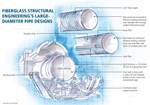Making continuous composite pipe
The continuous filament winding process was developed in the 1970s by Danish inventor Frede Hilmar Drostholm, and it was commercialized first by Toledo, Ohio-based Owens Corning’s engineered pipe systems business, in partnership with several entities, including Amiantit (Dammam, Saudi Arabia) and Vera Fabrikker (later Flowtite Pipe and Tank AS, Sandefjord, Norway). The ingenious process involves a cantilevered, horizontal rotating mandrel system.
The continuous filament winding process was developed in the 1970s by Danish inventor Frede Hilmar Drostholm, and it was commercialized first by Toledo, Ohio-based Owens Corning’s engineered pipe systems business, in partnership with several entities, including Amiantit (Dammam, Saudi Arabia) and Vera Fabrikker (later Flowtite Pipe and Tank AS, Sandefjord, Norway). The ingenious process involves a cantilevered, horizontal rotating mandrel system. Customizable to a range of pipe diameters, the mandrel is made up of longitudinal aluminum beams fitted with small outward-facing roller bearings, a series of discs (sized to the pipe to be produced) that support the beams and a steel “band,” or endless loop. As the mandrel rotates, the steel band, which is about 2 inches/51 mm wide, is wound over the beams by a placement head on the mandrel’s supported end. As it is wound, the band also is pulled and, therefore, moves over the roller bearings in the axial direction, advancing toward the other (open) end of the mandrel. At that end, an exit head directs the band back through the mandrel’s core to the supported end, where the placement head directs it onto the mandrel again. In this way, the wound band forms a continuously advancing, smooth tool surface onto which the pipe materials are applied, via filament winding heads on either side. The wound pipe is pulled along by the advancing band through a heated zone near the mandrel’s open end to cure. Then the cured pipe exits the mandrel system, and the continuous pipe is cut to the desired length for transport to the project site. Some manufacturers can produce more than 30m/hr (98 ft/hr), and the technology can currently fabricate pipe up to 4m/13 ft in diameter. To see a continuous filament winder in action, visit YouTube for several videos, including this one produced by large-pipe fabricator Technobell London (Harrow, Middlesex, U.K.): http://www.youtube.com/watch?v=YAdwxIELLDU&feature=player_embedded#at=220.
Related Content
-
Large-format 3D printing enables toolless, rapid production for AUVs
Dive Technologies started by 3D printing prototypes of its composite autonomous underwater vehicles, but AM became the solution for customizable, toolless production.
-
Plant tour: Joby Aviation, Marina, Calif., U.S.
As the advanced air mobility market begins to take shape, market leader Joby Aviation works to industrialize composites manufacturing for its first-generation, composites-intensive, all-electric air taxi.
-
PEEK vs. PEKK vs. PAEK and continuous compression molding
Suppliers of thermoplastics and carbon fiber chime in regarding PEEK vs. PEKK, and now PAEK, as well as in-situ consolidation — the supply chain for thermoplastic tape composites continues to evolve.











.jpg;maxWidth=300;quality=90)
